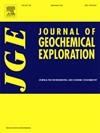Evaluation on rare earth elements and microbial communities in abandoned rare earth tailings
IF 3.4
2区 地球科学
Q1 GEOCHEMISTRY & GEOPHYSICS
引用次数: 0
Abstract
Rare earth elements (REEs) tailings present a pressing issue in terms of resource waste, with a lack of effective methods for evaluating and recycling these resources. This study aimed to establish an evaluation system and assess the potential for reutilization of REEs tailings. The study measured the contents of 14 REEs in two layers (0–15 cm, L1 and 15–30 cm, L2) of the tailings across different abandoned durations of 1.5-year (1.5-Y), 7-year (7-Y), 10-year (10-Y), and 14-year (14-Y), as well as an unmined site (CK), using inductively coupled plasma mass spectrometry (ICP-MS). Additionally, the characteristics and functions of microbial communities in the tailings were investigated; The amplified 16S rRNA gene and ITS gene were used to detect bacteria and fungi respectively. Results showed that total REEs content in surface tailings increased from 851.46 μg/g at 1.5-Y to 2133.81 μg/g at 14-Y, which can be attributed to vertical migration. The residue degree of REEs in the tailings ranged from 10.03 % to 21.57 %. The maximal fold to extraction ultimate value of REEs ranged from 1.31 (Ce) to 4.54 (Nd), while the maximal rate to initial ore value of REEs ranged from 0.279 (Ce) to 0.610 (Nd). Moreover, the maximal phyto-remining potential index ranged from 0.365 (Ce) to 2.768 (Nd), with values above 1.0 indicating potential for phyto-remining. Bradyrhizobium showed a positive correlation with all 14 individual REEs, whereas Burkholderia exhibited negative correlations with all 14 individual REEs among bacteria, In terms of fungi, Sagenomella, Suillus, and Trichoderma were positively correlated with all 14 tested REEs, while Chalara, Cenococcum, and Pseudotomentella displayed negative correlations with all 14 tested REEs. The REEs content significantly influenced the microbial communities in the tailings, particularly impacting fungal species during ecological restoration. The REEs tailings demonstrated promising potential for phyto-remining. These findings offer valuable insights into the recycling of REEs tailings.

废弃稀土尾矿中稀土元素及微生物群落评价
稀土尾矿资源浪费是一个亟待解决的问题,但缺乏有效的尾矿资源评价和资源化利用方法。本研究旨在建立稀土尾矿资源化利用评价体系,对稀土尾矿资源化利用潜力进行评价。采用电感耦合等离子体质谱法(ICP-MS)测定了不同废弃时间1.5年(1.5年)、7年(7年)、10年(10年)、14年(14年)以及未开采地点(CK)的尾矿中0-15 cm、15-30 cm两层(L2层)14种稀土元素的含量。此外,还研究了尾矿中微生物群落的特征和功能;扩增的16S rRNA基因和ITS基因分别用于细菌和真菌的检测。结果表明:地表尾矿中总稀土元素含量由1.5 y时的851.46 μg/g上升至14 y时的2133.81 μg/g,稀土元素的垂直迁移是主要原因;尾矿中稀土元素的残留量为10.03% ~ 21.57%。稀土元素与提取终值的最大比值为1.31 (Ce) ~ 4.54 (Nd),与初始矿值的最大比值为0.279 (Ce) ~ 0.610 (Nd)。最大植物记忆电位指数在0.365 (Ce) ~ 2.768 (Nd)之间,大于1.0表明存在植物记忆电位。细菌中,慢生根瘤菌与14种稀土元素均呈正相关,而布克霍尔德菌与14种稀土元素均呈负相关。真菌中,Sagenomella、Suillus和Trichoderma与14种稀土元素均呈正相关,而Chalara、cenococum和Pseudotomentella与14种稀土元素均呈负相关。稀土元素含量对尾矿中微生物群落的影响显著,对生态恢复过程中真菌种类的影响尤为显著。稀土尾矿具有很好的植物矿化潜力。这些发现为稀土尾矿的回收利用提供了有价值的见解。
本文章由计算机程序翻译,如有差异,请以英文原文为准。
求助全文
约1分钟内获得全文
求助全文
来源期刊

Journal of Geochemical Exploration
地学-地球化学与地球物理
CiteScore
7.40
自引率
7.70%
发文量
148
审稿时长
8.1 months
期刊介绍:
Journal of Geochemical Exploration is mostly dedicated to publication of original studies in exploration and environmental geochemistry and related topics.
Contributions considered of prevalent interest for the journal include researches based on the application of innovative methods to:
define the genesis and the evolution of mineral deposits including transfer of elements in large-scale mineralized areas.
analyze complex systems at the boundaries between bio-geochemistry, metal transport and mineral accumulation.
evaluate effects of historical mining activities on the surface environment.
trace pollutant sources and define their fate and transport models in the near-surface and surface environments involving solid, fluid and aerial matrices.
assess and quantify natural and technogenic radioactivity in the environment.
determine geochemical anomalies and set baseline reference values using compositional data analysis, multivariate statistics and geo-spatial analysis.
assess the impacts of anthropogenic contamination on ecosystems and human health at local and regional scale to prioritize and classify risks through deterministic and stochastic approaches.
Papers dedicated to the presentation of newly developed methods in analytical geochemistry to be applied in the field or in laboratory are also within the topics of interest for the journal.
 求助内容:
求助内容: 应助结果提醒方式:
应助结果提醒方式:


